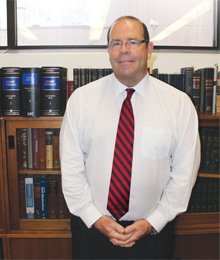The Crux of the Matter
September 27, 2012 by Madeline Stephenson
Filed under Success Story
 “What led me to where I am right now is kind of a circuitous journey,” says Dr. Andrew McCallum. The chief coroner for Ontario is sitting in a large, antiquated boardroom that’s covertly connected to his personal office in downtown Toronto. Behind him is a bookshelf brimming with encyclopedia-sized texts that advise on cerebral subjects such as expert evidence, fractures, forensic medicine and poisonings. From the strict security check-in to the closed-mouthed hallways, it’s the makings of a CSI: Crime Scene Investigation episode — but as McCallum contests, he’s no Al Robbins. “The big difference is that we focus on stuff that wouldn’t make great television but what really matters. I’m talking about, ‘how do you keep people alive?’”
“What led me to where I am right now is kind of a circuitous journey,” says Dr. Andrew McCallum. The chief coroner for Ontario is sitting in a large, antiquated boardroom that’s covertly connected to his personal office in downtown Toronto. Behind him is a bookshelf brimming with encyclopedia-sized texts that advise on cerebral subjects such as expert evidence, fractures, forensic medicine and poisonings. From the strict security check-in to the closed-mouthed hallways, it’s the makings of a CSI: Crime Scene Investigation episode — but as McCallum contests, he’s no Al Robbins. “The big difference is that we focus on stuff that wouldn’t make great television but what really matters. I’m talking about, ‘how do you keep people alive?’”
What he means by “circuitous” is that after finishing medical school, he worked in the Canadian Forces as a medical officer and flight surgeon, studied emergency medicine, then worked for 20 years as an emergency physician and trauma team leader. “I remember having to study [aviation] accidents which, to me, was maybe one of the geneses of my interest in forensics,” says McCallum, who was also involved in leadership positions at various hospitals. When a full-time opportunity arose in 2003 to become a supervising coroner, he fulfilled it, and in 2008 he transitioned from death scene investigations to the senior executive role of chief coroner for Ontario. He also flies planes in his “spare” time, which adds context to his close colleague Dirk Huyer’s comment that “he has a very high-level view on things.”
Part 1
Part 2
“It may be hard for people to understand, but it’s rewarding work,” says McCallum. More than 20,000 forensic death investigations take place at the Office of the Chief Coroner annually, but it’s the devastating story of Sabrina Shannon that stands out the most and inspires him to continue fulfilling his office’s mantra to “speak for the dead to protect the living.” The 13-year-old, who was highly allergic to peanuts, milk and soya, died from anaphylactic shock on September 30, 2003, after eating french fries from her school cafeteria that were believed to be cross-contaminated with cheese. Shannon was a well-informed child, she knew what questions to ask, but her EpiPen was across the hall and no one around her was thoroughly prepared to respond to such an event. “My daughter’s death was so preventable,” says Shannon’s tearful mother, Sara, over the phone.
“When Sabrina was dying, I held her hand and I made a promise to her that I’d do everything possible to prevent a similar tragedy from happening to another child’s family.” She immediately sent a letter requesting an investigation and McCallum, who was a regional supervising coroner at the time, agreed to take on the case. It was up to the coroner’s office to determine how, when, where and by what means the death occurred to gain insight and offset similar occurrences. Throughout the process, Sara was able to get the answers needed to start questioning a system riddled with holes.
While Sara began educating parents and teachers, McCallum used the findings to advocate for increased allergy awareness and demand safety measures in schools. Their full-scale efforts preceded the implementation of unprecedented legislation. Sabrina’s Law is an act that was introduced in 2006 to protect anaphylactic students by training staff on the administration of medication and ensuring that all Ontario school boards have a list of policies and procedures designed to deal with anaphylaxis. “Her mother is a wonderful person who has advocated in the most positive way in the most tragic circumstances,” says McCallum. “That’s the kind of case that really gives me hope for the future.” His comprehensive recommendations have gone beyond Sabrina’s Law and continue to be reviewed and implemented across borders. “Dr. McCallum gave me hope when there was no hope,” says Sara. Though she believes she’ll never receive closure until there is a cure, she finds comfort in knowing that it’s through her daughter’s death that many other lives will be saved.
Prevention is the crux of a coroner’s calling. The highly publicized cycling death review released last spring highlighted the consequences of not wearing a helmet and proposed amendments of the Highway Traffic Act to make them mandatory for all ages. The study found that every single one of Ontario’s 129 cycling fatalities between 2006 and 2010 could have been prevented. “Challenging cases are the ones where you say, ‘Gee, this definitely didn’t have to happen,’ and those are the cases that are frustrating when you see them reoccur,” says McCallum, an educator and father of two. The secret, in his eyes, lies in making technology modern and mandatory. He acknowledges he may be criticized for advocating a nanny state but when research shows that safety measures save lives, egos are irrelevant. “We’ve got evidence, for example, that wearing helmets or life jackets does save lives.” If you look solely at the statistics, his reasoning is clear. The drowning death review of 2010 confirmed that 22 of 23 people who died in boat-related incidents were not wearing personal floatation devices. “That’s pretty telling, I think.”
While the job is highly rewarding, being chief coroner means both acclaim and criticism come your way. The demands for public inquests aren’t always met and answers aren’t always delivered to families desperate for the closest thing to closure. McCallum, however, has learned how to handle it. “He’s very methodical. He steps back, thinks about what’s going on and analyzes. He’s very good at that,” says Huyer. “We try to be honest with people and let them know exactly that, while in the vast majority of cases we can provide answers, there are cases where, frustratingly, we just cannot,” says McCallum, underscoring the value of empathy in his vocation. “We’re dealing with a human being who has been lost to people who survived and they are hurting as a consequence of that grieving. I can’t overstate how important that is.”
Behind-the-times boardrooms will be a thing of the past for McCallum and his team, as they anticipate moving into their new futuristic Forensic Services and Coroner’s Complex in early 2013. Located at Wilson Avenue and Keele Street, the six-acre facility will feature a new expanded morgue centre, hot-zone autopsy suite and technologically advanced coroner’s court facilities that will enhance video networking, communication and security. “We’ve actually had it presented in several leading journals for forensics,” says McCallum, who believes the move will support the cultural and social evolution of death investigations. “It’s the envy of other systems.”
Whether it’s hopping on a bike without a helmet, sitting in a car without a seatbelt or lounging on a boat without a life jacket, there’s one message McCallum wants to publicize most: “I would just like people to take a moment to pause and reflect on when they’re about to do something: ‘is this a safe thing to do?’”















My daughter is one of the many children in Ontario who are protected through Sabrina’s Law. Every day, as she heads off to school, I am so thankful. I know that all of the staff at her school take anaphylaxis seriously and have been trained to recognize and respond should a reaction occur. I truly wish that I could say that all Canadian children are protected this way, but sadly this is not the case.
When will we ensure that all Canadian children are provided with a safe and free public education? How many more Sabrina’s need to die?